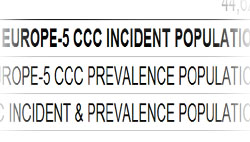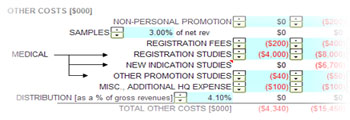|
Methods
SG Systems works hand-in-hand with the client's in-house or
consulting experts to develop extraordinarily robust,
user-friendly, and transparent valuation models.
Market Model
 Our first effort is to develop a market model.
This begins by working with the product developers to
determine the end-users' profiles. For pharmaceutical
products this often revolves around the targeted indications
and expected drug label. Then epidemiology data is
compiled and extrapolated and winnowed down. Incidence
and prevalence rates are layered, if necessary. Distribution
channels and market access are areas that require
close scrutiny. The aforementioned items along with a
variety of other variables help us derive our realistic
market model. Our first effort is to develop a market model.
This begins by working with the product developers to
determine the end-users' profiles. For pharmaceutical
products this often revolves around the targeted indications
and expected drug label. Then epidemiology data is
compiled and extrapolated and winnowed down. Incidence
and prevalence rates are layered, if necessary. Distribution
channels and market access are areas that require
close scrutiny. The aforementioned items along with a
variety of other variables help us derive our realistic
market model.
For more details see Case Study: Market Model
Revenue Model
Once we have a robust market model we need to determine how
much market share the product can command. Market
share not only depends on how 'great' the product is, but
how much 'greater' it is in comparison to marketed
competitive products, how much it costs in relation to these
other products, when and if the product comes off patent
protection, and many other factors which are all
interrelated. It is the accurate modeling of all of
the interrelated variables that creates a viable revenue
model.

For more details see
Case Study: Revenue
Model
Expense Model
 OK, so now you have a good feel for how much revenue the
product can turn in the expected market. Now we need
to build up the associated expense model. This is
often the most complex portion of the total product or
project valuation. Many variables enter the fray and
are often interdependent on each other in regards to
magnitude. Cost of Goods Sold [COGS] is certainly a
Variable Cost [VC] and is directly dependent on the amount
of expected product sales. Whereas Clinical Trials
[CTs] are more or less considered to be a Fixed Cost [FC]
for the project. The handling and calculating of the
myriad of expenses is a crucial step in the valuation
process. Make a mistake here and you could either
severely underestimate the required capitalization or pinch
the projected profit margins and lose investors. OK, so now you have a good feel for how much revenue the
product can turn in the expected market. Now we need
to build up the associated expense model. This is
often the most complex portion of the total product or
project valuation. Many variables enter the fray and
are often interdependent on each other in regards to
magnitude. Cost of Goods Sold [COGS] is certainly a
Variable Cost [VC] and is directly dependent on the amount
of expected product sales. Whereas Clinical Trials
[CTs] are more or less considered to be a Fixed Cost [FC]
for the project. The handling and calculating of the
myriad of expenses is a crucial step in the valuation
process. Make a mistake here and you could either
severely underestimate the required capitalization or pinch
the projected profit margins and lose investors.
For more details see
Case Study: Expense
Model
Deal Terms / Licensing & Partnering
Many major trade-off decisions, for example licensing versus
in-house product distribution, are made within the expense
model. Deal terms are ironed out within the expense model. When should milestones be paid? How much should each
of those milestones be? What, if any, upfront payments
should be made? If licensing, what are the
various royalty rates and thresholds? These are very
critical items that need to be modeled in a very accurate,
transparent, and easy to use form. Otherwise do you
really know the cards that you can play when making a deal?
The more information at your disposal that is clear, easy to
understand, and relevant will provide you with a significant
level of competitive advantage. And if you don't have
this competitive advantage, your 'partner' certainly will.
See our Licensing
and Partnering page for more details.
Cash Flow Model
The cash flow model is often times placed at the tail end of
the expense model or sometimes built up as a separate
entity. It is in the cash flow model where we
essentially determine taxable income, the overall tax effect
of the product with all of the carry-forward tax benefits,
net income, the overall cash flow, capitalization
requirements, terminal values, and finally a Net Present
Value [NPV] of the project. All of the milestones,
paid out or received, need to be accounted for by adding
back or subtracting out the amortized milestones along with
other non-cash items [i.e. CapEx]. In addition, the
working capital items such as 'inventory held' and 'accounts
receivable' need to be accounted for.
We also build in a NPV Split to determine whether or not the
deal is fair to both you and your partner. The NPV
Split essentially is a build up of the partner's expected
revenues versus expected expenses. Much of the partner
information derived empirically or by other means.
See our Licensing
and Partnering page for more details.
|
If you know
the enemy and know yourself, you need not fear
the result of a hundred battles. --
SunTzu |
|

